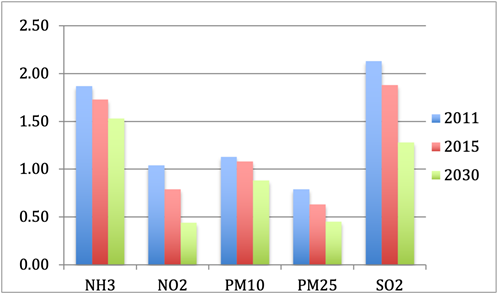Reducing polluting gas emissions
Upsides
i) Emissions of air pollutants from wildfire have been calculated as substantially degrading air quality with wildfire PM2.5 (particulate matter of 2.5 microns) concentrations linked to health problems1.
ii) Surface concentrations of PM2.5 from the Saddleworth Moor wildfire were 4–5.5 times higher than recent seasonal averages and increased by more than 300% locally and by 50% in areas up to 80 km away. The estimated impact of PM2.5 mortality due to that fire was £21.1 m2.
iii) The estimated average aircraft-measured Emission Factor (PM1) from wildfires is more than twice that of controlled fires and where controlled burning reduces the prevalence of wildfires there may be a net benefit by reducing overall PM emissions3. Unlike managed fire, wildfires pose a particularly high risk of particulate matter emissions and the release of ‘stored’ pollutants. Emissions, particularly of PM2.5, are likely to change over the course of a wildfire due to the change in fuel source from surface vegetation (with emission estimates ranging from 6.3–15.3 g/kg for vegetation types burned) to the underlying peat (with higher emissions per unit burnt - estimated range from 6–30 g/kg) (emissions estimates from Global Fire Emissions Database v42).
iv) The nature of peatland wildfires (well-oxygenated, high emissions and dense ground level smoke) means that their impacts on air pollution may differ from other wildfire types2.
v) Methane releases from natural sources such as wildfires and wetlands are projected to increase, thereby affecting air quality through increasing ozone concentrations. Recent research has demonstrated how methane removal can not only mitigate against global climate change but also improve air quality4.
Downsides
vi) The incomplete burning of vegetation generates particulate matter and polycyclic aromatic hydrocarbons (PAHs)5,6 with unit area emissions possibly around half of those from wildfire (see above).
vii) Agricultural machinery used for cutting that are not Euro-6 compliant are likely to be a contributor to air pollutant emissions; however, the extent of this is not quantified.
Challenges
viii) Public policy constraint on heather burning (most recently the Heather and Grass etc. Burning (England) Regulations 20217) is likely to increase unburnt vegetative fuel load (i.e. heather, grass and scrub biomass), which may increase the risk and severity of wildfire8 and, consequently, the amount of PM emissions.
ix) Wildfire events are often linked to human recreation with access rates being a proxy for availability of ignition sources – climate change may increase this risk due to increasing visitor numbers9. The Met Office’s Fire Severity Index10 indicates when wildfire risk is high enough to require the closure of open-access land.
x) Degraded peatlands, and peatlands during a drought, are a particular wildfire risk11,12.
Removing air pollutants
Upsides
xi) The ONS estimated the annual valuation of pollution removal for Mountains, Moorlands and Heaths (MMH) at £10.9 million in 2017, on the basis of avoided healthcare costs13. The UK’s MMH covers 3,664,200 hectares and so this equates to £2.97/ha. Using this value we estimate that the 423,000 hectares under English grouse moor management removes £1.26m of pollutants annually.
xii) Traits associated with heather moorland and peatlands vegetation enhance PM capture notably surface roughness, leaf surface morphology and multi-species habitats14.
Downsides
xiii) Open canopy woodland has been shown to be an effective pollution trap15 but comparative research has not been undertaken on peatlands and heather moorlands.
xiv) The ONS estimated that removal of air pollution by UK woodland equated to an annual saving of £938.0 million in health costs in 201716. This equates to approximately £293/ha or c100 times that of MMH.
xv) The removal of air pollutants by vegetation impacts habitat quality through acidification and nitrogen enrichment, encouraging vegetation changes away from the specialist peatland species17.
Challenges
xvi) In recent years the deposition of atmospheric sulphur is likely to have fallen below the ‘critical load’ likely to threaten peat bogs in good condition, but the damage done to peatlands in the South Pennines in particular is only slowly being reversed18.
xvii) The impacts of pollution reduction and removal on habitat quality and other environmental goods and services are complex and have been summarised at http://www.apis.ac.uk/ecosystem-services-and-air-pollution-impacts and in IUCN briefing paper 13 (2016)18.
xviii) Air pollution emissions have fallen and so the value of this service will continue to decline. The ONS13 notes that this is largely based on reductions in ozone emissions with PM2.5 representing the lowest proportion of all pollution removal included in the ONS analysis.
 Figure 1: UK emissions (thousands of tonnes) in 2011, 2015 and 2030 forecast.13
Figure 1: UK emissions (thousands of tonnes) in 2011, 2015 and 2030 forecast.13